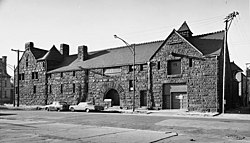Prairie Avenue District
Prairie Avenue District | |
Chicago Landmark | |
 The John J. Glessner House by Henry Hobson Richardson is located within the Prairie Avenue District. | |
| Location | Chicago, Illinois |
|---|---|
| Coordinates | 41°51′26″N 87°37′19″W / 41.85722°N 87.62194°W |
| Built | 1836–1892 |
| Architect | Henry Hobson Richardson |
| Architectural style | Renaissance, Romanesque |
| NRHP reference No. | 72000452 [1] |
| Significant dates | |
| Designated HD | November 15, 1972[1] |
| Designated CL | December 27, 1979 |
The Prairie Avenue District is a historic district in the
Prairie District Neighborhood Alliance
The Prairie District Neighborhood Alliance (PDNA) is a non-profit resident organization in Chicago.[3][4] The PDNA provides support and benefits to residents, condominium and town home associations, businesses, cultural institutions, and organizations who reside within the area and who agree to and support the purpose of the alliance.[5]
Activities
On September 6, 2008, the organization hosted the 'Festival on Prairie Avenue,' with Mayor
Achievements
The PDNA and its residents banded together to successfully save the Vietnam Veterans Art Museum building at 1801 S. Indiana Avenue, a cultural pillar of the neighborhood, from being sold privately and converted into a night club.[7][8][9] Instead, the building was purchased by the city of Chicago and conveyed to the Chicago Park District to become a new community center.[10][11] The PDNA presented recommendations to the Commission on Chicago Parks and the alderman to name an important new park which is located near 18th and Calumet Avenue, the site which marks the 1812 Fort Dearborn Massacre.[12][13]
On August 15, 2009 (the anniversary of the battle), the PDNA joined with the community to commemorate and officially name the site the Battle of Fort Dearborn Park; and unveiled an historic marker outlining the site's significance.[14] The PDNA aims to bring much needed[citation needed] infrastructure and retail to the area.[15]
Landmarks

Built in 1836 and untouched by the great Chicago fire of 1871, the Clarke House is Chicago’s oldest house and is a classic example of the Greek revival style. Moved twice, and opened as a house museum in 1982, it features 19th century furnishings depicting life on the urban frontier. The John J. Glessner House was designed in 1885 by architect Henry Hobson Richardson and completed in late 1887. Both properties were designated Chicago landmarks on October 14, 1970. The Clarke and Glessner houses are key PDNA partners.
With such rapid growth in the South Loop, residents who live within the Prairie District Neighborhood Alliance boundaries have become increasingly concerned about the quality of new development and the quality of work performed on properties being converted to residential use.[16][17][18] Condo boards and residents have begun to band together to make their voices heard. A few have achieved high-profile status. Additionally, the PDNA and area residents work with the city government to actively review proposed development projects in an effort to encourage smart growth.[19] This is to protect the architectural character of the historic Prairie Avenue district.[20][21]
Notes
- ^ a b "National Register Information System". National Register of Historic Places. National Park Service. April 15, 2008.
- ^ a b c "Prairie Avenue District". City of Chicago Department of Planning and Development, Landmarks Division. 2003. Archived from the original on June 7, 2007. Retrieved May 12, 2007.
- ^ Prairie District Neighborhood Alliance
- ^ "South Loop Rising, Faces of the South Loop" Chicago Magazine, June 2007.
- ^ "South Loop strives for identity as a new neighborhood evolves" New Homes Magazine, October 24, 2007.
- ^ "Oddball on the wrecking crew" Chicago Journal, September 3, 2008.
- ^ "Park District acquires South Loop property" Chicago Journal, November 21, 2007
- ^ "Park District gains property" New West Gazette, August 2008.
- ^ "Vets Museum goes to Park District" Chicago Journal, June 27, 2007.
- ^ "Party in a war zone" Chicago Reader, March 3, 2007.
- ^ "Café Society rumbles" Chicago Journal, February 14, 2007.
- ^ "Park likely to be named for Black Partridge" Archived 2009-01-05 at the Wayback Machine New West Gazette, August 2007.
- ^ "Renaming: Black Partridge Park?" Chicago Journal, May 24, 2007.
- ^ "Blood on the ground" Chicago Reader, March 23, 2007.
- ^ "Density envisioned around future el stops", Chicago Journal, November 19, 2008.
- ^ "The perfect shock" Chicago Sun Times, February 16, 2007.
- ^ "I don't know. Why are you bothering me?" Chicago Sun Times, February 16, 2007.
- ^ "Proposed zoning change threatens South Loop project"[dead link] Crain's Chicago Business, July 20, 2007.
- ^ "PDNA wants X/O investigation: planning department refuses" New West Gazette, April 3, 2007.
- ^ "Haithcock promises to stall X/O, again" Chicago Journal, March 7, 2007.
- ^ "Pie in the sky" Chicago Journal, January 21, 2007.


